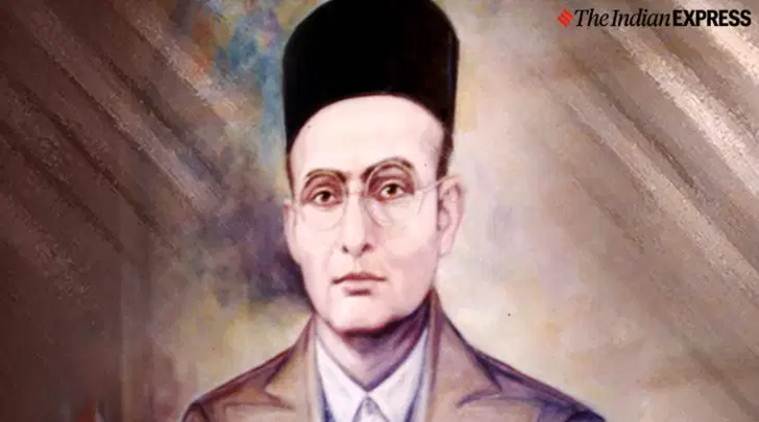 Savarkar, like the RSS, refused to accept the Tricolour as the national flag or flag of the freedom struggle.
Savarkar, like the RSS, refused to accept the Tricolour as the national flag or flag of the freedom struggle.
The Karnataka government led by B S Yediyurappa wants to honour Hindutva icon, V D Savarkar, by naming two of newly-built flyovers in Bengaluru and Mangaluru after him. There was a huge uproar against this decision of the BJP government as many Opposition parties and liberal-secular organisations questioned the logic of ignoring many freedom fighters, social reformers and others from within the state in favour of Savarkar.
It would be a sad day not only for Karnataka but the whole country if Savarkar is honoured in this manner, given his stance on a variety of issues.
Savarkar, like the RSS, refused to accept the Tricolour (at that time there used to be a charkha or spinning wheel in the middle of it) as the national flag or flag of the freedom struggle. In a statement issued on September 22, 1941, for the benefit of Hindu Mahasabha (HM) cadres, he declared: “So far as the flag question is concerned, the Hindus know no flag representing Hindudom as a whole than the ‘Kundalini Kripanankit’ Mahasabha flag with the ‘Om and the Swastik’ the most ancient symbols of the Hindu race and policy coming down from age to age and honoured throughout Hindusthan…The Charkha-Flag can never symbolise and represent the spirit of the proud and ancient nation like the Hindus.”
When Netaji Subhas Chandra Bose, after escaping from India on January 16, 1941, was trying to secure foreign support for the liberation of the country and to organise a military attack in the Northeast which finally culminated in the formation of Indian National Army, it was Savarkar who offered full military cooperation to the British. While addressing the 23rd session of the Hindu Mahasabha at Bhagalpur in 1941, he explained the extent to which the organisation was willing to help the British. “So far as India’s defence is concerned, Hindudom must ally unhesitatingly, in a spirit of responsive co-operation with the war effort of the Indian government [British] in so far as it is consistent with the Hindu interests, by joining the Army, Navy and the Aerial forces in as large a number as possible and by securing an entry into all ordnance, ammunition and war craft factories…without losing a single minute.”
Savarkar spent the next couple of years in organising recruitment camps for the British armed forces which were to slaughter the cadres of INA.
Savarkar also believed that India is not one nation but consisted of two nations as claimed by M A Jinnah and the Muslim League. Delivering the presidential address to the 19th Hindu Mahasabha (HM) session at Ahmedabad in 1937, Savarkar declared: “As it is, there are two antagonistic nations living side by side in India, several infantile politicians commit the serious mistake in supposing that India is already welded into a harmonious nation, or that it could be welded thus for the mere wish to do so… but on the contrary there are two nations in the main: the Hindus and the Moslems, in India.”
In 1942, during the Quit India movement, the Congress was banned and only the HM and Muslim League were allowed to function. As the whole country was facing brutal repression by the British, Savarkar declared: “The Hindu Mahasabha holds that the leading principle of all practical politics is the policy of responsive co-operation [with the British].” He called upon all Hindu sanghatanists working as councillors, ministers, legislators and conducting any municipal or any public bodies to support the British government. He made it clear “The policy of responsive co-operation which covers the whole gamut of patriotic activities from unconditional co-operation right up to active and even armed resistance, will also keep adapting itself to the exigencies of the time, resources at our disposal and dictates of our national interest.” [Italics as in the original]
The HM under Savarkar’s leadership ran coalition governments with the Muslim League in the 1940s. Publicly defending this collusion with the Muslim League, Savarkar in his presidential speech to the 24th session of Hindu Mahasabha at Kanpur in 1942 declared: “In practical politics also the Mahasabha knows that we must advance through reasonable compromises. Witness the fact that only recently in Sind, the Sind-Hindu-Sabha on invitation had taken the responsibility of joining hands with the League itself in running coalition Government. The case of Bengal is well known. Wild Leaguers whom even the Congress with all its submissiveness could not placate grew quite reasonably compromising and sociable as soon as they came in contact with the HM…” Both joined hands in running the government in the NWFP as well.
Savarkar may be a “veer” for the Hindutva camp, but the fact is that he wrote more than six mercy petitions and got a remission of almost 40 years in a 50-year sentence.
The writer taught political science at the University of Delhi